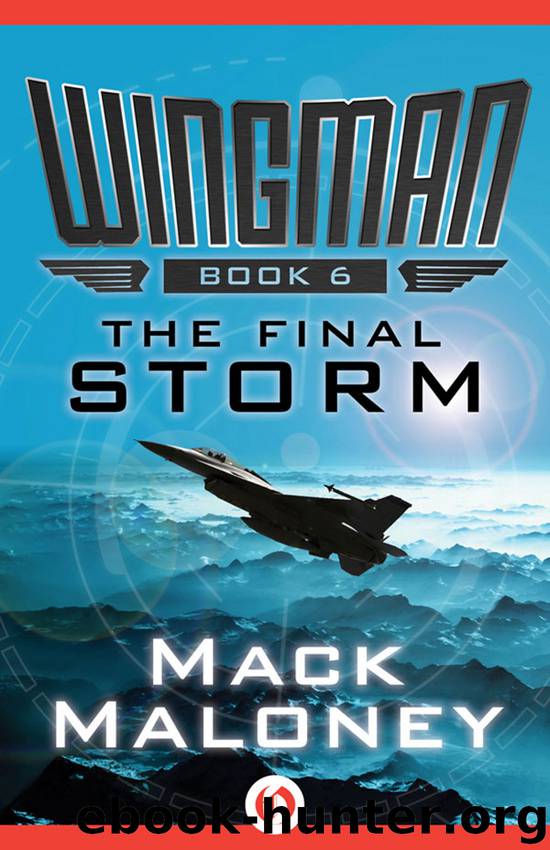Final Storm by Maloney Mack

Author:Maloney, Mack [Maloney, Mack]
Language: eng
Format: epub
ISBN: 9781480406711
Publisher: Open Road Media
Published: 2013-04-23T23:16:00+00:00
Chapter 25
CLIMBING HIGH INTO THE sun above Rota, Hunter tucked the landing gear under the wings and leveled off.
The rest of the 16TFW was already aloft and grouped. Hunter moved up into the formation and took his customary place off Jones’s right wing. They circled high above the base like that for the next ten minutes until the rest of the NATO aircraft were airborne and grouped. Then, as one, the huge air armada set out to engage the enemy in the gray skies over France.
Much maneuvering followed as Jones ordered the “Wild Weasel” F-4 Phantoms to go ahead first, followed closely by the F-15s, the Tornados, and the smaller F-16s. His reasoning, he had explained to Hunter in the briefing room, was to send the first sweep over enemy-held territory in successive waves, leading off with the SAM-killing, radar-jamming Weasels to put a dent in the Soviets’ air defense system. They would have the advantage of surprise, and even a temporary edge in numbers, until the enemy figured out what was going on. More than a hundred Phantoms, each carrying four HARM anti-radar missiles, would have the Soviet gunners thinking the sky had fallen on them, in large, high-explosive pieces.
But it would also tip off the Reds that something big was up, and bells would go off all the way from the front back to Moscow. Once the size of the NATO force was reported, the Soviets would be forced to launch all available aircraft, starting with their state-of-the-art fighters. That’s why Jones wanted his heavy artillery to go in first. The allied air-superiority fighters like the F-15s, the Tornados and the dogfighting F-16s would draw the Soviets’ first echelon interceptors—Su-27 Flankers, MiG-29 Fulcrums, plus the new MiG-31 Foxhounds—into battle in its opening stages.
If the NATO top dogs could hold the Reds off until the second wave of NATO fighters—launching from Holland—arrived, the Soviets would have no choice but to call up some of their reserves, thus matching the French Mirages and F1s, plus the rest of the interceptor F-4s and F-5s, with the roughly equivalent MiG-23s and Su-17 Fitters.
Following the same progression, the next wave of NATO planes—coming in from England—would include the older Star-fighters, the National Guard Delta Darts and Daggers, the A-7s, and the G-91s. Ideally, they would face the East Bloc nations’ less modern MiG-21 Fishbeds and Su-15 Flagons; and so on down to the scraps at the bottom of both forces’ barrels: NATO antiques like the Turks’ F-100 Super Sabres and the National Guard Voodoos, plus the Brits’ Jaguars would be engaging MiG-19 Farmers and Su-9 Fishpots of similar vintage.
But Hunter and Jones both knew that such equivalent matchups were by no means preordained—if the Soviets held back a few flights of Fulcrums or Foxhounds, they would make mincemeat of the slower NATO fighters in the later waves. But this was a gamble and they had to reason that such rough parity would exist, if only in the first few hours of the battle.
One
Download
This site does not store any files on its server. We only index and link to content provided by other sites. Please contact the content providers to delete copyright contents if any and email us, we'll remove relevant links or contents immediately.
| Crime | Mystery |
| Thriller & Suspense |
The Book of Dreams (Saxon Series) by Severin Tim(33331)
Who'd Have Thought by G Benson(16526)
Always and Forever, Lara Jean by Jenny Han(14845)
Bull's Eye Sniper Chronicles Collection (The Second Cycle of the Betrayed Series) by McCray Carolyn(12326)
Firetrap: The Soul Scorchers MC (The Scorched Souls Serial-series Book 1) by Riley C.L(11107)
Warriors (9781101621189) by Young Tom(10781)
Fourth Wing by Rebecca Yarros(10036)
Oathbringer by Brandon Sanderson(9571)
Thirteen Reasons Why by Jay Asher(8833)
The City of Brass by S. A. Chakraborty(8812)
Red Rising by Pierce Brown(8676)
The Thirst by Nesbo Jo(6876)
Storm and Silence by Robert Thier(6796)
Shadows Of The Apt [01] - Empire in Black and Gold by Adrian Tchaikovsky(6666)
Pandemic (The Extinction Files Book 1) by A.G. Riddle(6483)
Six Wakes by Mur Lafferty(6195)
Assassin’s Fate by Robin Hobb(6161)
The Demon Crown: A Sigma Force Novel by James Rollins(5769)
The Fall of Dragons by Miles Cameron(5534)
